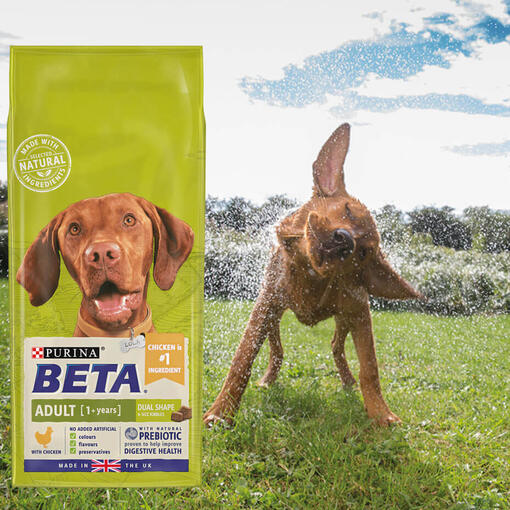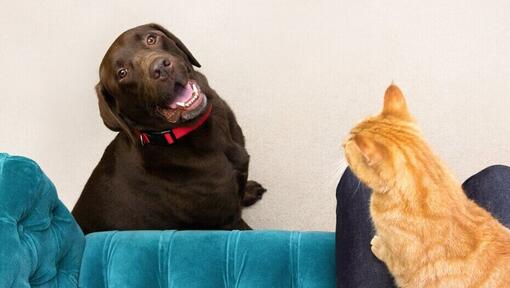
Dogs and cats can live together in perfect harmony, but sometimes there can be a little tension. Dogs are pack animals who love company, while cats are lone hunters who prefer independence. Dogs often play with other pups by chasing them, which cats may perceive as a threat.
Stopping this behaviour the moment it occurs is very important, as it can lead to a very unhappy cat if left unchecked, even if your dog is well-meaning. Moreover, your cat will interpret it as predatory behaviour and will want to hide in order to feel safe.
But fear not – this behaviour can be controlled. In this article, we’ll explore why dogs chase cats, how to stop dogs from chasing your cats, and what to do if they do not stop.
Why do dogs chase cats?
When a dog chases a cat, it is usually because they are following their instincts – particularly if your dog is a breed originally used for chasing or herding. Other times, when a dog chases cats, they might just want to play, and they will chase a cat a little like they will chase a ball that has been thrown for them.
Dogs chase cats because they have a strong chase instinct and that movement can trigger this instinct. However, there are instances of dogs living with cats for years without chasing them before suddenly developing this instinct.
It is important to stop dogs chasing cats as soon as you see this behaviour in your own pets. Dogs should see cats as their companions, and not as toys.
A step-by-step guide on how to stop dogs chasing cats
If you’re wondering how to stop dogs from chasing cats, we have come up with two different methods below for you to try. It is much easier to train your dog if they are a puppy, as you can easily socialise your dog into recognising that chasing cats is not acceptable behaviour.
Method 1 - Be in control of their attention
If your cat is happy in a cat crate, put them in and place the crate in a room (when your puppy is not around). Make sure they have their toys to keep them entertained.
Then, bring in the puppy. Instantly, your puppy will be intrigued by the cat; they will try and smell them and pester them. Try and command your dog’s attention to you each time they approach the cat. If the dog looks at you, reward them with a treat.
The aim is to do this each time your dog looks at the cat (not necessarily goes up to them). Each time they look at the cat, call them and when they come to you, reward them with treats. This will emphasise that they should not bother the cat. They will associate leaving the cat alone with being rewarded.
Release your cat (if it is safe to do so) and try again. If your dog persists in approaching the cat, call them to you and reward them when they obey. If they don’t, firmly tell them stop, remove the cat, and try again later. In time, they will learn this behaviour and stop chasing after the cat.
Sometimes, though, your dog develops this chasing behaviour later in life. In such cases, you may need a more detailed plan to try and stop your dog from chasing the cat.
Method 2 - Call the dog to you
If your dog starts chasing a cat, instantly call their attention to you. Stop what you are doing to make sure they come to you when they are called. This is important, because you want to stop the chase before it begins. Distracting your dog is always a good way to establish boundaries.
Each time your dog notices your cat, repeat the above action. Use strong commands if they have been taught to your dog, such as ‘stop’ or ‘leave it’.
If your dog begins chasing your cat, it is important to stop the chase. Follow your dog and use verbal commands to show your disapproval. Sternness of voice should get across the idea that chasing a cat is not sanctioned behaviour and your dog should stop instantly.
If this method does not stop your dog from chasing the cat, you may need to employ a different method.
Method 3 – Use an adjustable lead
If your dog keeps chasing the cat, try keeping your dog on an adjustable-length lead in the house. Make sure the lead is tied to you or is easily accessible. Keep treats on hand.
When your dog looks at the cat, call their attention to you. If they come, give them a treat. Repeat this behaviour each time your dog looks at your cat. The lead will make sure your cat can roam freely without being chased and it will give you better control of your dog should they not obey your commands.
In time, your dog will start looking automatically at you when the cat is in the vicinity. Here, you can lengthen the lead and let your dog roam a bit more. If then the dog chases the cat, take them back on the lead to control them. If they come to you, reward them.
Once your dog shows little to no interest in chasing your cat both when close to you and when on a long lead, allow them to roam freely with the cat.
Remember, lots of treats for good behaviour will help get your point across and stop your dog chasing the cat.
Other ways to stop dogs from chasing cats
If your dog won’t stop chasing cats, you may need to consider if there are any new factors in their life that may have brought this on. For instance, is your dog getting enough exercise? If not, they may be trying to use up some of their extra energy by chasing your cat around the house. Try taking them out for longer and more challenging walks.
If this does not work, consider taking your dog to an obedience trainer or a dog behaviour specialist. These professionals will be able to identify the problem and solve it.
If you’re still wondering how to stop dogs chasing cats, it’s important to remember that sometimes behavioural changes are brought about by illnesses. If this is a concern, take them to a vet to make sure nothing is wrong.
For more dog training guides, check out our article on basic dog training commands, next.











